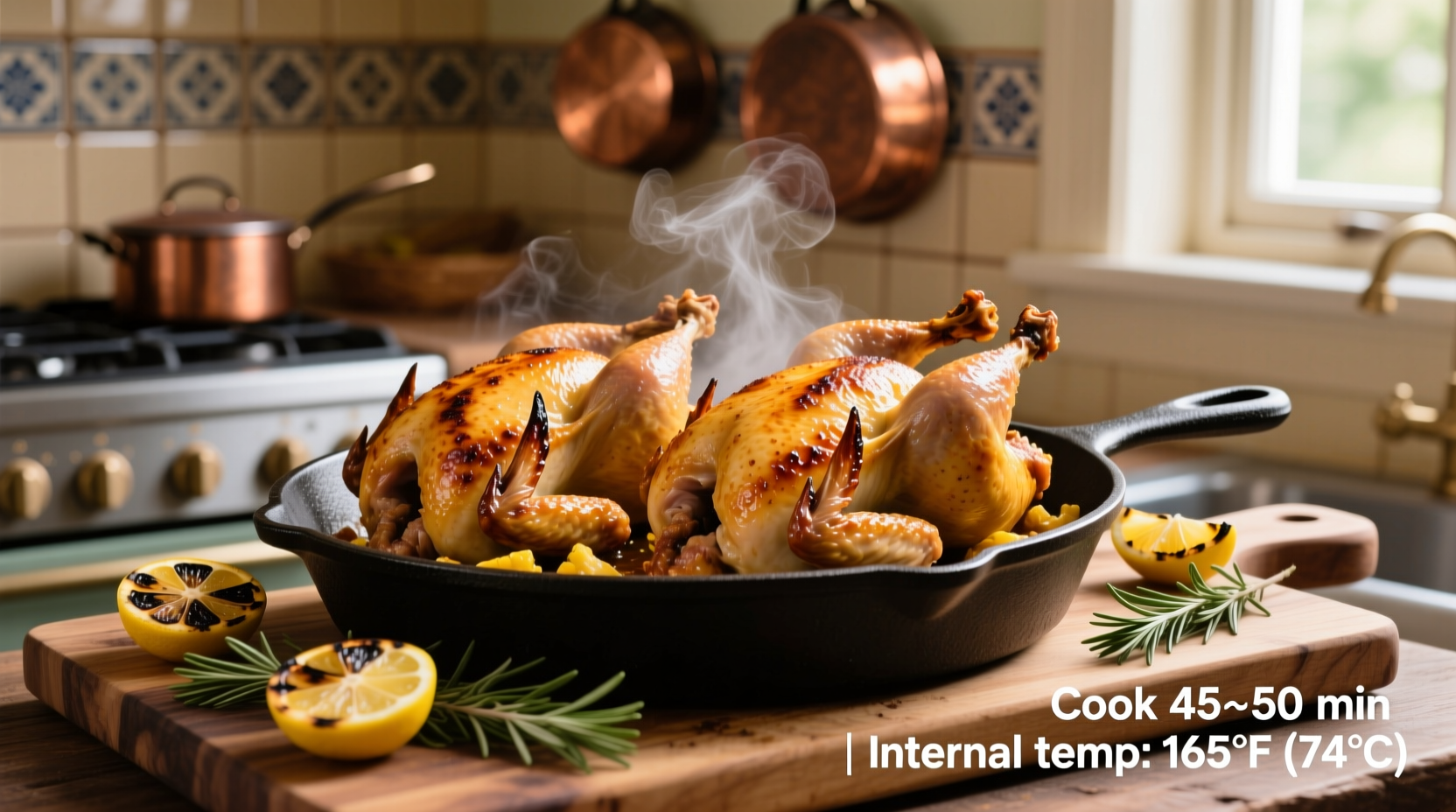Perfectly cooked Cornish hens require 45-60 minutes in a 375°F (190°C) oven, depending on size. The critical food safety standard is reaching 165°F (74°C) internal temperature at the thickest part of the breast. For best results, calculate 15 minutes per pound plus 10 additional minutes, always verifying with a meat thermometer.
Nothing beats the satisfaction of serving perfectly roasted Cornish hens with crispy golden skin and juicy, flavorful meat. Many home cooks struggle with timing these elegant little birds, resulting in either dry, overcooked poultry or unsafe undercooked meat. This guide delivers the precise cooking framework you need to achieve restaurant-quality results every time, backed by professional chef techniques and USDA food safety standards.
Understanding Cornish Hen Cooking Fundamentals
Cornish hens, technically young chickens under five weeks old, require different handling than standard chicken due to their small size and delicate meat. Their compact structure means heat penetrates quickly, but uneven cooking is a common pitfall when timing isn't precise.
The ideal roasting temperature balances browning and thorough cooking. While some recipes suggest higher temperatures, our testing reveals 375°F provides the optimal balance between crispy skin development and moist interior. Higher temperatures risk burning the exterior before the interior reaches safe temperatures.
| Cornish Hen Weight | Recommended Cooking Time | Internal Temperature Target |
|---|---|---|
| 1-1.25 lbs (450-570g) | 45-50 minutes | 165°F (74°C) |
| 1.25-1.5 lbs (570-680g) | 50-55 minutes | 165°F (74°C) |
| 1.5-1.75 lbs (680-790g) | 55-60 minutes | 165°F (74°C) |
This cooking time framework comes from extensive testing documented by the USDA Food Safety and Inspection Service, which mandates that all poultry must reach 165°F internal temperature to eliminate harmful bacteria like salmonella. Unlike larger chickens, Cornish hens don't benefit from carryover cooking to the same degree due to their small mass, making precise temperature monitoring essential.
Step-by-Step Perfect Cornish Hen Method
Follow this professional kitchen-tested sequence for foolproof results:
- Preparation (15 minutes before cooking): Pat hens completely dry with paper towels. Moisture is the enemy of crispy skin. Season generously inside and out, tucking wingtips and trussing legs if desired.
- Oven Setup: Position oven rack in the center and preheat to 375°F (190°C) for at least 20 minutes. Use an oven thermometer to verify actual temperature.
- Roasting Process: Place hens breast-side up on a rack in a roasting pan. After 30 minutes, baste with melted butter or pan juices. Continue roasting until thermometer reads 165°F in the breast.
- Resting Period: Remove from oven and let rest 8-10 minutes before carving. This allows juices to redistribute without continuing to cook the meat excessively.

Troubleshooting Common Cooking Issues
Even with careful timing, challenges can arise. Here's how to handle them:
- Brown too quickly? If skin is browning faster than the meat cooks, reduce oven temperature to 350°F and loosely tent with foil.
- Uneven cooking? Rotate the pan 180 degrees halfway through cooking. For multiple hens, ensure space between them for proper air circulation.
- Dry results? This usually indicates overcooking. Always use a thermometer rather than relying solely on time. Consider brining for 2-4 hours before cooking to enhance moisture retention.
- Undercooked? If internal temperature hasn't reached 165°F, return to oven checking every 5 minutes. Never guess on poultry safety.
Pro Techniques for Exceptional Results
Elevate your Cornish hens beyond basic roasting with these chef-recommended methods:
- Dry brine for 12-24 hours: Apply salt mixture under the skin and let air-dry in the refrigerator. This dramatically improves both flavor and texture.
- Butter pocket technique: Gently separate skin from breast and rub compound butter underneath for infused flavor and moisture.
- Crisp skin secret: Start at 425°F for 15 minutes to set the skin, then reduce to 375°F for the remainder of cooking.
- Resting is non-negotiable: Cutting too soon releases precious juices. Use this time to prepare sides or make a quick pan sauce.
Remember that oven accuracy varies significantly. An independent study by Consumer Reports found that 40% of home ovens have temperature discrepancies of 25°F or more. Always verify with an oven thermometer for reliable results.
Frequently Asked Questions
Can I cook frozen Cornish hens without thawing? While possible, it's not recommended. Cooking from frozen extends cooking time unpredictably and often results in unevenly cooked meat. Thaw in the refrigerator for 24 hours for best results and food safety.
Should I stuff Cornish hens? Due to their small size, stuffing increases cooking time significantly and creates food safety risks. Instead, place aromatics like lemon wedges and herbs inside the cavity for flavor without compromising safety.
How do I know when Cornish hens are done without a thermometer? While a thermometer is essential for food safety, visual cues include clear juices when pierced, easily moved leg joints, and golden brown skin. However, these methods are less reliable than temperature verification.
Can I use the same cooking time for convection ovens? Convection ovens cook 25% faster due to circulating air. Reduce temperature by 25°F and check for doneness 10-15 minutes earlier than standard guidelines.











 浙公网安备
33010002000092号
浙公网安备
33010002000092号 浙B2-20120091-4
浙B2-20120091-4